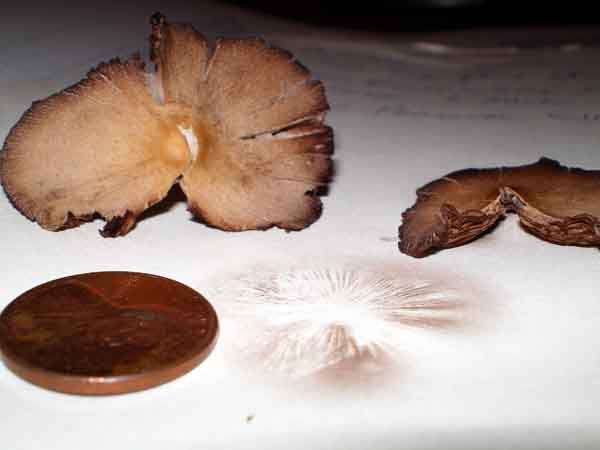Mushrooms!
Mushrooms!
-
-
-
-
-
Mushrooms!
-
Post #1 - August 9th, 2007, 1:18 pmInspired by the talk C2 organized at Kendall College last Saturday, I was pleased to find a bunch of these mushrooms around the crabapple tree in my front yard today. They don't look like anything dangerous, but based on what I know I can't identify them. I've included a spore print and a penny for size reference. Gills are dark brown. Anyone want to help?

-
-
Post #2 - August 9th, 2007, 2:32 pmYou could always give them a taste. Make sure there is a family member who can let us know if they ended up dangerous.
 "Beer is proof God loves us, and wants us to be Happy"
"Beer is proof God loves us, and wants us to be Happy"
-Ben Franklin-
-
-
Post #3 - August 9th, 2007, 2:51 pmFlip wrote:You could always give them a taste. Make sure there is a family member who can let us know if they ended up dangerous.

As they say, everyone can try a mushroom once.
-
-
Post #4 - August 9th, 2007, 3:05 pm"Little brown mushrooms"
A "little brown mushroom" or LBM refers to any of a large number of small, dull-colored agaric species, with few macromorphological characters that readily distinguish one species from another. As a result, LBMs are typically difficult to impossible for mushroom hunters to identify.
http://en.wikipedia.org/wiki/Mushroom_hunting
http://en.wikipedia.org/wiki/Mushroom_poisoning
-
-
Post #5 - August 10th, 2007, 10:37 pmI've eaten similar looking ones and they were good. The gills should be white. I wouldn't eat yours because they have deteriorated too much. Gotta get to them early, before the critters and bugs start feasting, or they rot.What if the Hokey Pokey really IS what it's all about?
-
-
Post #6 - August 11th, 2007, 2:58 amThey probably would have been okay to eat, but I threw them out ... it was only a couple of ounces, and they were looking kinda sad by the time I would have gotten around to cooking them. But again, inspired by the talk C2 organized, my eyes are open for new mushroom acquisitions. (I may have to make a surreptitious trip to a forest preserve area where I've seen puffballs and sulfur shelf mushrooms.)
-
-
Post #7 - August 16th, 2007, 5:52 pmnr706 wrote:They probably would have been okay to eat, but I threw them out ... it was only a couple of ounces, and they were looking kinda sad by the time I would have gotten around to cooking them. But again, inspired by the talk C2 organized, my eyes are open for new mushroom acquisitions. (I may have to make a surreptitious trip to a forest preserve area where I've seen puffballs and sulfur shelf mushrooms.)
I've been following thread with a bit of dismay. Joe McFarland was very clear in stating not to eat a mushroom unless you were 100% certain what you had. While I appreciate the hopefullness and enthusiasm to consume wild mushrooms you hand picked. There is no compelling reason to have considered eating the mushroom pictured because 1) It wasn't easy to identify even the Lincoln penny; 2) I think nobody could say with 100% certainty what was present in that photo. (I may have an opinion, but I am not saying.)
There are some mushrooms that are unmistable to identify, without unpleasant look-alikes, like the morel, sulphur shelf, shaggy manes, hen of the woods and puffballs. You can buy a book though (me) on seven easy to ID mushrooms costing less than $10. For $20, you can join the Illinois Mycological Association going on forays and attending meetings with fresh specimens present to ID.
Another issue with picking off the lawn are the herbicides that may have been applied. You need to know that habits of your neighbors or get ill due to issues unrelated to the mushroom.
I have friends who work or consult to poison control. They are not too thrilled to review people's stomach contents trying to pick out details. It is far more considerate to leave one specimen in the refrigerator for them to review later, if necessary.
There are plenty of joys to mushrooming, though there are risks that are considerably minimized by some education.
Regards,Cathy2
"You'll be remembered long after you're dead if you make good gravy, mashed potatoes and biscuits." -- Nathalie Dupree
Facebook, Twitter, Greater Midwest Foodways, Road Food 2012: Podcast
-
-
Post #8 - August 16th, 2007, 5:56 pmCathy2 wrote: It wasn't easy to identify even the Lincoln penny.
I'm dying here. No, not really, but you kill!!
Cathy2 wrote: It is far more considerate to leave one specimen in the refrigerator for them to review later, if necessary.
"Later," as part of the post-mortem? "Don't you ever underestimate the power of a female." Bootsy Collins
"Don't you ever underestimate the power of a female." Bootsy Collins

